The N-terminal region of RTP1S plays important roles in dimer formation and odorant receptor-trafficking
- PMID: 31395660
- PMCID: PMC6779431
- DOI: 10.1074/jbc.RA118.007110
The N-terminal region of RTP1S plays important roles in dimer formation and odorant receptor-trafficking
Abstract
Receptor-transporting protein 1S (RTP1S) is an accessory protein that mediates the transport of mammalian odorant receptors (ORs) into the plasma membrane. Although most ORs fail to localize to the cell surface when expressed alone in nonolfactory cells, functional expression of ORs is achieved with the coexpression of RTP1S. However, the mechanism for RTP1S-mediated OR trafficking remains unclear. In this study, we attempted to reveal the mode of action and critical residues of RTP1S in OR trafficking. Experiments using N-terminal truncation and Ala substitution mutants of RTP1S demonstrated that four N-terminal amino acids have essential roles in OR trafficking. Additionally, using recombinant proteins and split luciferase assays in mammalian cells, we provided evidence for the dimer formation of RTP1S. Furthermore, we determined that the 2nd Cys residue is required for the efficient dimerization of RTP1S. Altogether, these findings provide insights into the mechanism for plasma membrane transport of ORs by RTP1S.
Keywords: G-protein–coupled receptor (GPCR); dimerization; flow cytometry; membrane transport; molecular chaperone; odorant receptors; receptor-transporting protein.
© 2019 Fukutani et al.
Conflict of interest statement
The authors declare that they have no conflicts of interest with the contents of this article
Figures
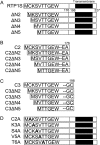
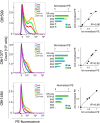
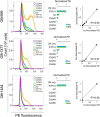
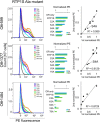





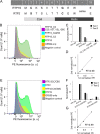
Similar articles
-
Receptor-transporting protein 1 short (RTP1S) mediates translocation and activation of odorant receptors by acting through multiple steps.J Biol Chem. 2012 Jun 22;287(26):22287-94. doi: 10.1074/jbc.M112.345884. Epub 2012 May 8. J Biol Chem. 2012. PMID: 22570474 Free PMC article.
-
Receptor-transporting protein (RTP) family members play divergent roles in the functional expression of odorant receptors.PLoS One. 2017 Jun 6;12(6):e0179067. doi: 10.1371/journal.pone.0179067. eCollection 2017. PLoS One. 2017. PMID: 28586385 Free PMC article.
-
Activation state of the M3 muscarinic acetylcholine receptor modulates mammalian odorant receptor signaling.Sci Signal. 2011 Jan 11;4(155):ra1. doi: 10.1126/scisignal.2001230. Sci Signal. 2011. PMID: 21224444 Free PMC article.
-
Mammalian olfactory receptors: molecular mechanisms of odorant detection, 3D-modeling, and structure-activity relationships.Prog Mol Biol Transl Sci. 2015;130:1-36. doi: 10.1016/bs.pmbts.2014.11.001. Epub 2014 Dec 18. Prog Mol Biol Transl Sci. 2015. PMID: 25623335 Review.
-
Molecular Basis of Mammalian Odor Discrimination: A Status Report.J Agric Food Chem. 2018 Dec 26;66(51):13346-13366. doi: 10.1021/acs.jafc.8b04471. Epub 2018 Dec 7. J Agric Food Chem. 2018. PMID: 30453735 Review.
Cited by
-
Hot Spot Mutagenesis Improves the Functional Expression of Unique Mammalian Odorant Receptors.Int J Mol Sci. 2021 Dec 28;23(1):277. doi: 10.3390/ijms23010277. Int J Mol Sci. 2021. PMID: 35008703 Free PMC article.
-
AAV-delivered muscone-induced transgene system for treating chronic diseases in mice via inhalation.Nat Commun. 2024 Feb 6;15(1):1122. doi: 10.1038/s41467-024-45383-z. Nat Commun. 2024. PMID: 38321056 Free PMC article.
-
Interactions among key residues regulate mammalian odorant receptor trafficking.FASEB J. 2022 Jul;36(7):e22384. doi: 10.1096/fj.202200116RR. FASEB J. 2022. PMID: 35639289 Free PMC article.
-
Structural instability and divergence from conserved residues underlie intracellular retention of mammalian odorant receptors.Proc Natl Acad Sci U S A. 2020 Feb 11;117(6):2957-2967. doi: 10.1073/pnas.1915520117. Epub 2020 Jan 23. Proc Natl Acad Sci U S A. 2020. PMID: 31974307 Free PMC article.
-
Correlation between olfactory receptor basal activity and odor response: An observational study.Medicine (Baltimore). 2025 Apr 25;104(17):e42085. doi: 10.1097/MD.0000000000042085. Medicine (Baltimore). 2025. PMID: 40295251 Free PMC article.
References
Publication types
MeSH terms
Substances
Grants and funding
LinkOut - more resources
Full Text Sources
Molecular Biology Databases

